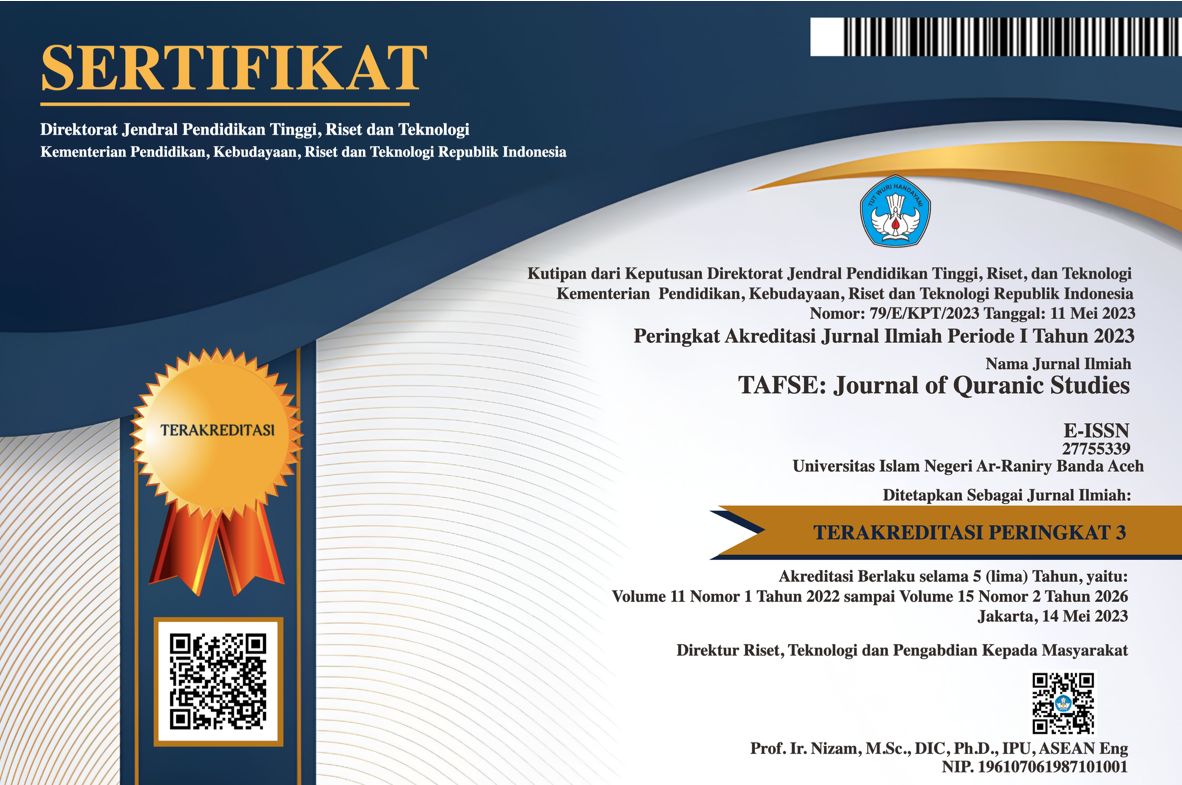Kompromisasi Kontradiksi Makna Tiupan Sangkakala dalam Al-Qur’an
DOI:
https://doi.org/10.22373/tafse.v3i2.13275Keywords:
Kompromisasi, Kontradiksi, Sangkakala, Hari kiamatAbstract
The beginning of the apocalypse is when the first and second trumpets are blown. QS. al-Mu'minun verse 101 explains that after the trumpet blast, the two humans will be resurrected separately, kinship relations are no longer valid and there are no more questions. However, QS. Thaha verses 102-104 state that when he is resurrected, there are people who ask each other questions. This paper wants to discuss the interpretation of the scholars of the interpretation of the contradictions of the text of the verses about the blowing of the trumpet. The results showed that the trumpet blast in QS. al-Mu'minun verse 101 and Thaha verse 102-104 are both the second trumpet blast but in a different human context. QS. al-Mu'minun verse 101 talks about humans as a whole where when they are resurrected they are in their own state without any family relationship. While QS. Thaha verses 102-104 talk about the disbelievers and when they are resurrected they will have a blue face. The commentators interpret the textual contradiction of the verse by saying that humans do not speak when they are on their way to Padang Mahsyar and the condition of wondering occurs when humans are already in the Mahsyar field.
Permulaan terjadi kiamat adalah ketika sangkakala pertama dan kedua ditiupkan. QS. al-Mu’minun ayat 101 menjelaskan bahwa setelah tiupan sangkakala kedua manusia akan dibangkitkan dalam keadaan sendiri-sendiri, tidak berlaku lagi hubungan kekerabatan dan tidak ada lagi yang bertanya-tanya. Namun, QS. Thaha ayat 102-104 menyatakan bahwa ketika dibangkitkan ada di antara manusia yang saling bertanya-tanya. Tulisan ini ingin mendiskusikan penafsiran ulama tafsir terhadap kontradiksi teks ayat-ayat tentang tiupan sangkakala. Hasil penelitian menunjukkan bahwa yang dimaksud tiupan sangkakala pada QS. al-Mu’minun ayat 101 dan Thaha ayat 102-104 adalah sama-sama tiupan sangkakala yang kedua, namun dalam konteks manusia yang berbeda. QS. al-Mu’minun ayat 101 berbicara tentang manusia secara keseluruhan dimana ketika dibangkitkan mereka dalam keadaan sendiri-sendiri tidak ada hubungan keluarga. Sedangkan QS. Thaha ayat 102-104 membicarakan tentang orang kafir dan ketika dibangkitkan mereka dalam keadaan wajah berwarna biru. Ulama tafsir memaknai kontradiksi tekstual ayat tersebut dengan mengatakan bahwa manusia tidak berkata-kata ketika berada dalam perjalanan menuju ke Padang mahsyar dan kondisi bertanya-tanya terjadi ketika manusia sudah berada di padang mahsyar.
Downloads
References
Ahmad Taufiq. Negri Akhirat (Konsep Eskatologi Nuruddin Ar-Raniry), Cet. I. Solo: PT Tiga Serangkai Pustaka Mandiri, 2003.
Mahir Ahmad ash-Shufi, Ensiklopedi Akhir Zaman. Terj. Tim Penerjemah Ummul Qura, Cet. I. Jakarta Timur: Ummul Qura, 2017.
Malik bin Muhammad al-Qasim. Menyikapi Kehidupan Dunia, Cet. 2. Bogor: Pustaka Ibnu Katsir, 2005.
Manshur Abdul Hakim. Kiamat: Tanda-Tanda menurut Islam, Kristen dan Yahudi, Cet. 1. Jakarta: Gema Insani, 2006.
Muhammad al-Razi Fakhr al-Din. Tafsīr Fakhr al-Razi, Juz 21, Cet. 1. Beirut: Dar al-Fikr, 1981.
Muhammad Ali ash-Shabuni. Tafsīr Ṣafwatu al-Tafāsīr, Jilid 3, Terj. Yasin, Cet. 1. Jakarta: Pustaka al-Kautsar, 2001.
Muhammad bin Ibrahim. Ensiklopedi Islam Kaffah, Terj. Najib Junaidi, dkk, Cet. 6. Surabaya: Pustaka Yassir, 2016.
Murtadha Muthahhari. Man and Universe, Terj. Ilyas Hasan, Cet. 3. Jakarta: PT Lentera Basritama, 2002.
Muslim Nurdin. Hidup di Empat Alam, Cet. 1. Jakarta Timur: Basmallah, 2011.
Sayyid Qutub. Tafsīr fi Ẓilali Alquran, Jilid. 8, Terj. As’ad Yasin, dkk, Cet. 1. Jakarta: Gema Insani, 2004.
Shafiyyurahman al-Mubarakfuri. Tafsir Ibnu Katsir, Terj. Abu Ahsan Sirojuddin Hasan Bashri, Cet. 3. Jakarta: Pustaka Ibnu Katsir, 2010.
Syahrin Harahab dan Hasan Bakti Nasution. Ensiklopedia Akidah Islam, Cet. 1. Jakarta: Kencana, 2009.
Wahbah al-Zuhayli. Al-Tafsir al-Wasith, Jilid 2, Terj. Muhtadi, Cet. 1. Depok: Gema Insani, 2013.
M. Quraish Shihab. Tafsīr al-Miṣbāh, Vol. 14, Jakarta: Lentera Hati, 2012.
Downloads
Published
Issue
Section
License
Authors who publish with this journal agree to the following terms:
- Authors retain copyright and grant the journal right of first publication with the work simultaneously licensed under a Creative Commons Attribution License (CC BY NC 4.0) that allows others to share the work with an acknowledgment of the work's authorship and initial publication in this journal.
- Authors are able to enter into separate, additional contractual arrangements for the non-exclusive distribution of the journal's published version of the work (e.g., post it to an institutional repository or publish it in a book), with an acknowledgment of its initial publication in this journal.
- Authors are permitted and encouraged to post their work online (e.g., in institutional repositories or on their website) prior to and during the submission process, as it can lead to productive exchanges, as well as earlier and greater citation of published work (See The Effect of Open Access).





